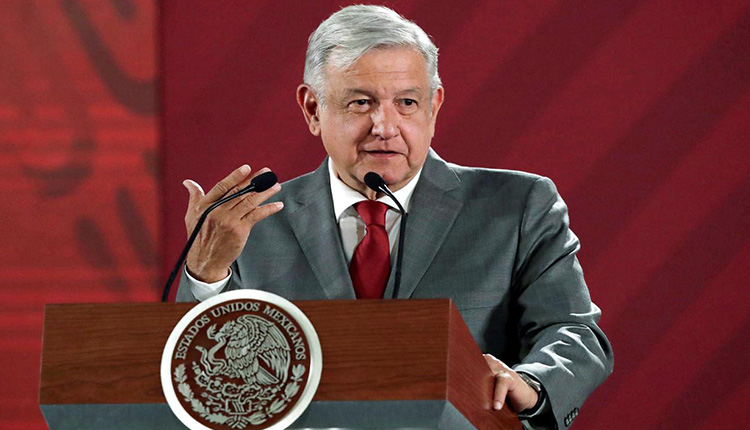Mexican president on Saturday hinted his country could tighten migration controls to defuse U.S. President Donald Trump’s threat to impose tariffs on Mexican goods, and said he expected “good results” from talks planned in Washington next week.
Trump says he will apply the tariffs on June 10 if Mexico does not halt the flow of illegal immigration, largely from Central America, across the U.S.-Mexican border.
His ultimatum hit Mexican financial assets and global stocks, but met resistance from U.S. business leaders and lawmakers worried about the impact of targeting Mexico, one of the United States’ top trade partners.
In a news conference in the Gulf of Mexico port of Veracruz, President Andres Manuel Lopez Obrador said Mexico could be ready to step up measures to contain a recent surge in migration in order to reach a deal with the United States.
A major Mexican delegation led by Foreign Minister Marcelo Ebrard will discuss the dispute with U.S. officials in Washington on Wednesday, and Lopez Obrador said he expected “good results” from the talks, and for a deal to emerge.
“The main thing is to inform about what we’re already doing on the migration issue, and if it’s necessary to reinforce these measures without violating human rights, we could be prepared to reach that deal,” Lopez Obrador said.
His comments follow those of Jesus Seade, deputy foreign minister for North America, who told Reuters on Friday that Mexico wanted to sharpen existing measures to curb the flow of Central Americans trying to reach U.S. soil.
Trump’s threat to inflict pain on Mexico’s economy is the biggest foreign policy test to date for Lopez Obrador and a tall order for Mexican authorities struggling not only to contain migration but also to fight record gang violence.
Mexico’s economy relies heavily on exports to the United States and shrank in the first quarter. Under Trump’s plan, U.S. tariffs that could rise as high as 25% this year.
Lopez Obrador said Mexico would not pursue trade wars with the United States, but noted that his government had a “plan” in case Trump did apply the tariffs to ensure the country was not impoverished. He did not provide details of the plan.
“We’re doing all we can to reach a deal through dialogue,” the veteran leftist said. “We’re not going to get into a trade war, a war of tariffs and of taxes.”
He nevertheless noted that Mexico reserved the right to seek international legal arbitration to resolve the dispute.
Meanwhile, some Mexican business groups have urged the government to strike back against any Trump tariffs.
On Friday, Mexico’s top farm lobby said Lopez Obrador should target agricultural goods from states that support Trump’s Republican Party if the American leader carries out his threat to punish Mexico for the migrants heading north.
Apprehensions at the U.S. border with Mexico have surged in recent months, though Mexican data also show more deportations and detentions at Mexico’s southern border with Guatemala, mostly of Central Americans trying to reach the United States illegally.
Those statistics are likely to figure in the Mexican government’s argument that it is addressing the problem.
The bulk of migrants are fleeing widespread violence and poverty in Guatemala, Honduras and El Salvador. Many seek asylum in the United States when they cross the border.
Trump is pushing Congress to change U.S. law to make it more difficult for the migrants to claim asylum.
The U.S. president, who has embraced protectionism as part of an “America First” agenda aimed at reshaping global trade, said in a tweet on Thursday he would ratchet up tariffs on Mexico “until the Illegal Immigration problem is remedied.”
The plan would impose a 5% tariff on Mexican imports starting on June 10 and increase monthly, up to 25% on Oct. 1.
Lopez Obrador was asked in the news conference whether he would allow Mexico to become a so-called safe third country, which would allow U.S. authorities to send migrants back to Mexico and make them apply for asylum there.
He did not answer the question, but pressure has grown steadily on his government to give ground on the issue.
Following an agreement with Lopez Obrador, U.S. authorities have since January begun sending migrants back to Mexico to wait there while their U.S. asylum claims are being processed.
The number of ports of entry for returnees under the so-called Remain in Mexico policy has gradually increased, and policy experts say it could be expanded to more cities.
Trump is pushing Congress to change U.S. law to make it more difficult for the migrants to claim asylum.
The U.S. president, who has embraced protectionism as part of an “America First” agenda aimed at reshaping global trade, said in a tweet on Thursday he would ratchet up tariffs on Mexico “until the Illegal Immigration problem is remedied.”
The plan would impose a 5% tariff on Mexican imports starting on June 10 and increase monthly, up to 25% on Oct. 1.
Lopez Obrador was asked in the news conference whether he would allow Mexico to become a so-called safe third country, which would allow U.S. authorities to send migrants back to Mexico and make them apply for asylum there.
He did not answer the question, but pressure has grown steadily on his government to give ground on the issue.
Following an agreement with Lopez Obrador, U.S. authorities have since January begun sending migrants back to Mexico to wait there while their U.S. asylum claims are being processed.
The number of ports of entry for returnees under the so-called Remain in Mexico policy has gradually increased, and policy experts say it could be expanded to more cities.
source: Reuters



